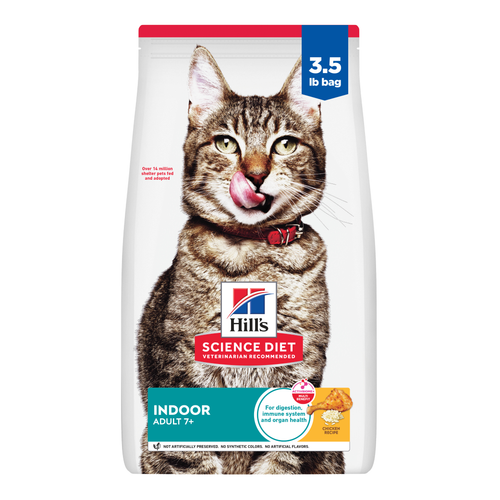
-
Find the right food for your petTake this quiz to see which food may be the best for your furry friend.Find the right food for your petTake this quiz to see which food may be the best for your furry friend.Featured products
 Hill's Science Diet Adult Chicken & Beef Entrée Dog Food
Hill's Science Diet Adult Chicken & Beef Entrée Dog FoodChicken & Beef Entrée in a delicious loaf with complete & balanced nutrition to help keep adult dogs active and healthy
Shop Now Adult Chicken & Barley Recipe Dog Food
Adult Chicken & Barley Recipe Dog FoodSupports lean muscle and beautiful coat for adult dogs
Shop Now Adult Large Breed Chicken & Barley Recipe Dog Food
Adult Large Breed Chicken & Barley Recipe Dog FoodSupports healthy joints, lean muscle, and beautiful coat for large breed dogs
Shop NowFeatured products Adult 7+ Indoor Chicken Recipe Cat Food
Adult 7+ Indoor Chicken Recipe Cat FoodSupports energy level and beautiful fur in mature indoor cats
Shop Now Adult Turkey & Liver Entrée Cat Food
Adult Turkey & Liver Entrée Cat FoodPrecisely balanced nutrition with the delicious taste of minced turkey & liver to help fuel the energy needs of cats during the prime of their life
Shop Now Senior Vitality Adult 7+ Tuna & Vegetables Stew
Senior Vitality Adult 7+ Tuna & Vegetables StewImproves Everyday Ability to Get Up & Go
Shop Now -
Dog
- Dog Tips & Articles
-
Health Category
- Weight
- Food & Environmental Sensitivities
- Urinary
- Digestive
- Joint
- Kidney
-
Life Stage
- Puppy Nutrition
- Adult Nutrition
- Senior Nutrition
Cat- Cat Tips & Articles
-
Health Category
- Weight
- Skin & Food Sensitivities
- Urinary
- Digestive
- Kidney
-
Life Stage
- Kitten Nutrition
- Adult Nutrition
Featured articles What Is Littermate Syndrome? Pet Adoption Guide
What Is Littermate Syndrome? Pet Adoption GuideLearn more about littermate syndrome in dogs and cats and how to successfully navigate adoption and early socialization processes.
Read More How to Properly Mix Wet & Dry Pet Foods
How to Properly Mix Wet & Dry Pet FoodsAn Orange cat eating from a bowl filled with mixed food
Read More The Science Behind Our Love for Pets
The Science Behind Our Love for PetsLearn the scientific reasons why we have such strong connections with our pets, and what science says about the love between humans and our furry friends.
Read More -


The look and feel of a lustrous hair coat is one of the joys of sharing your life with a dog. Many of us judge our pet's health by a shiny coat, so it's no surprise that skin and coat concerns are the most common reasons for veterinary exams.1 When skin or coat problems occur, the pet parent is often advised to add a supplement containing omega-6 and omega-3 fatty acids to the pet's daily regimen. But in many cases, a simple food change may be the answer.
The Roles of Omega-6 and Omega-3
Both omega-6 and omega-3 fatty acids help maintain healthy skin, promote a strong immune system, and play a role in cell growth. If a dog is not getting enough of these essential fatty acids, the classic signs of deficiency may appear, including:
- dry, flaky skin
- dull coat
- dermatitis
- hair loss
The appropriate amounts of omega-6 and/or omega-3 fatty acids may benefit dogs with skin, coat or certain other problems. This can be accomplished by feeding foods rich in essential fatty acids, by adding fatty acid supplements, or both.2 The most convenient and economical solution is to feed a pet food rich in essential fatty acids.
Key points
- Skin and hair coat problems are the most common reasons for veterinary exams1
- Omega-6 and omega-3 fatty acids are vital for skin and coat health
- Hill's® Science Diet® Adult Advanced Fitness Original Canine pet food is a rich source of essential fatty acids


Tasty Tips
More Than Supplements
There's a very simple way to provide dogs the fatty acids they need for a healthy skin and coat — feed Hill's® Science Diet® Adult Advanced Fitness Original Canine pet food. Advanced Fitness is a rich source of omega-6 and omega-3 fatty acids. In fact it would take 14 capsules of a typical fatty acid supplement to equal the essential fatty acids in a bowl of Advanced Fitness.3
Eliminate the Hassles
None of us looks forward to the prospect of giving our pet a pill or unnecessary supplements. In some cases, fatty acid supplementation may prove beneficial for dogs with chronic or severe diseases. But for the normal, healthy dog, the cost and hassle of supplementing fatty acids isn't necessary. Simply feed a food that's rich in essential fatty acids — Science Diet Adult Advanced Fitness Original Canine pet food.
1 Roudebush P, Schoenherr WD. Skin and Hair Disorders. In: Hand MS, Thatcher CD, Remillard RL, et al., eds. Small Animal Clinical Nutrition, 5th ed. Topeka, KS: Mark Morris Institute; 2010:637.
2 Scott DW, Miller DH, Griffi n CE. Muller & Kirk's Small Animal Dermatology, 6th ed. Philadelphia, PA: W.B. Saunders Co; 2001:367.
3 Vetri-Science Omega-3,6,9. Vetri-Science Laboratories Website. http://www.vetriscience.com. Accessed June 16, 2010.
Related products

Supports lean muscle and beautiful coat for adult dogs

Chicken & Barley Entrée in a delicious loaf with great taste and precisely balanced nutrition to support 5 essential building blocks for lifelong health

Supports healthy joints, lean muscle, and beautiful coat for large breed dogs

Chicken & Beef Entrée in a delicious loaf with complete & balanced nutrition to help keep adult dogs active and healthy
Related articles

Wondering where can I buy a dog? Consider adoption and explore the pros and cons of adopting a dog from a breeder versus an animal shelter.

Learn how to help keep your dog's immune system in tip-top shape, including nutritional immune system support for dogs and other strategies.

Discover how the field of dog science is giving us more and more insights into the inner workings of our furry best friends.

Your dog's coat and skin are a big part of your dog's overall health. Ensure you keep your dog's coat healthy, by following these simple tips.

Put your dog on a diet without them knowing
Our low calorie formula helps you control your dog's weight. It's packed with high-quality protein for building lean muscles, and made with purposeful ingredients for a flavorful, nutritious meal. Clinically proven antioxidants, Vitamin C+E, help promote a healthy immune system.
Put your dog on a diet without them knowing
Our low calorie formula helps you control your dog's weight. It's packed with high-quality protein for building lean muscles, and made with purposeful ingredients for a flavorful, nutritious meal. Clinically proven antioxidants, Vitamin C+E, help promote a healthy immune system.


